Suicide Kermit was living an ideal* life before the housing market decided to fuck him in the ass. Now he lives in his car and wants to die. Buy Kermit hot food or help pay his massive tow bill: ko-fi.com/suicidekermit420
Don't wanna be here? Send us removal request.
Text
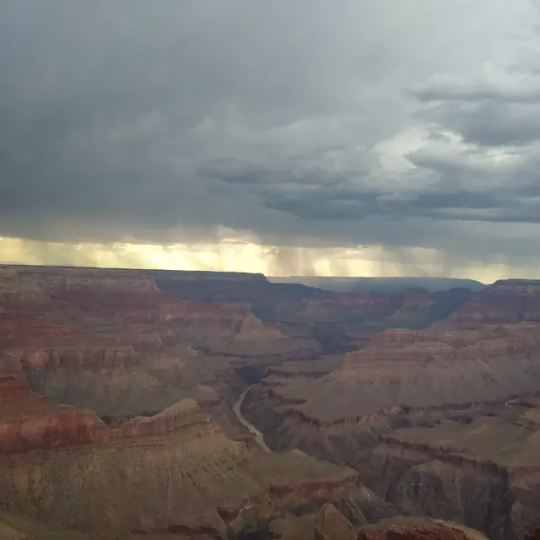
Kermit drove to the North Rim of the Grand Canyon, where he talked to many interesting people from around the world--a woman from Belgium, man from Germany, an elderly woman from China.
He hiked along the rim trail because hiking into the canyon itself would have been way too dangerous, considering the heat and elevation change. People die in the Grand Canyon all the time!
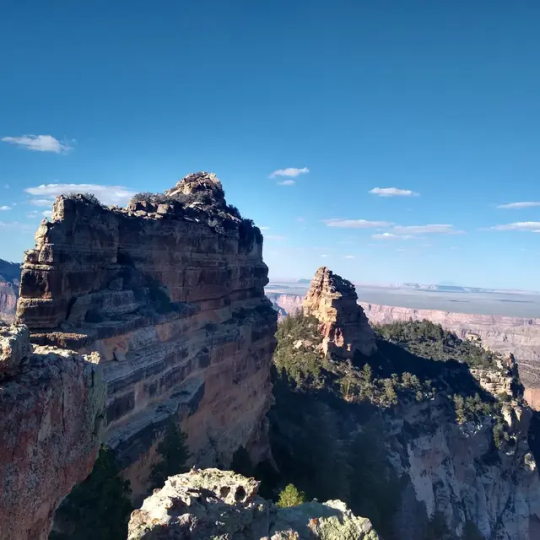
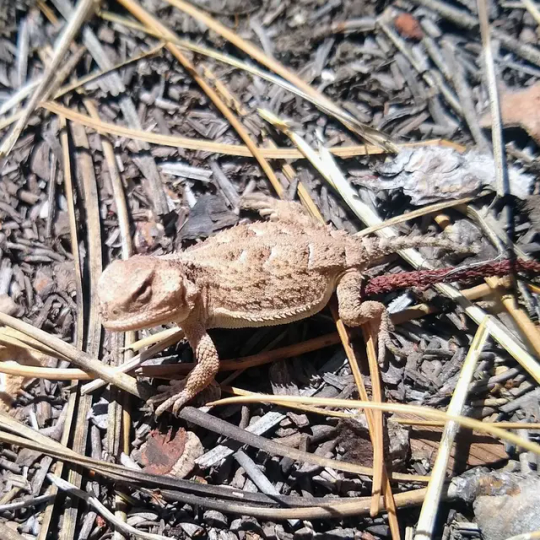
The North Rim was beautiful. It wasn't crowded like the South Rim would be, and because of it's higher elevation it is part of an alpine ecosystem, with ponderosa pines, while the rest of the canyon is arid desert.
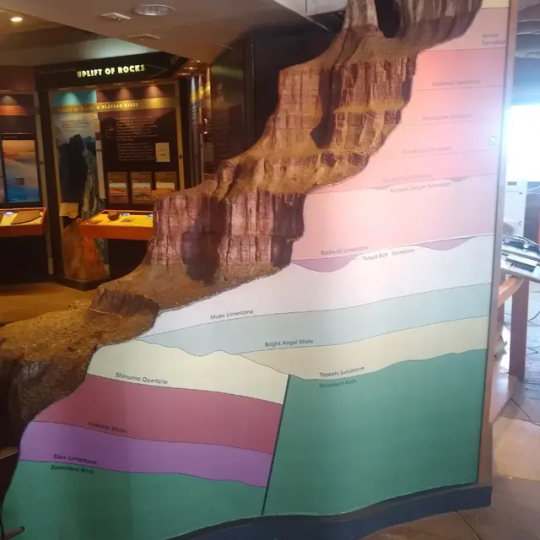
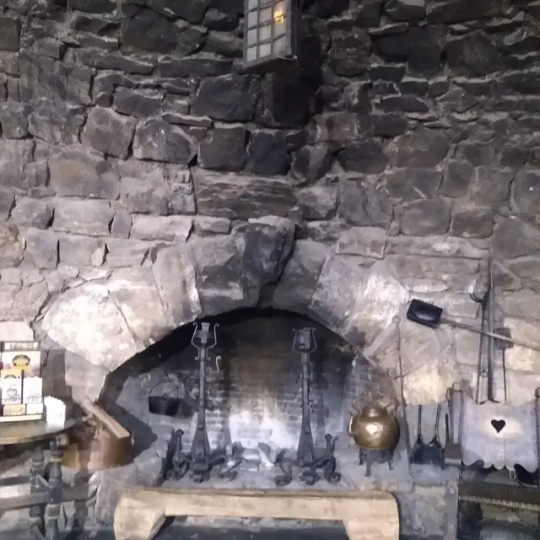
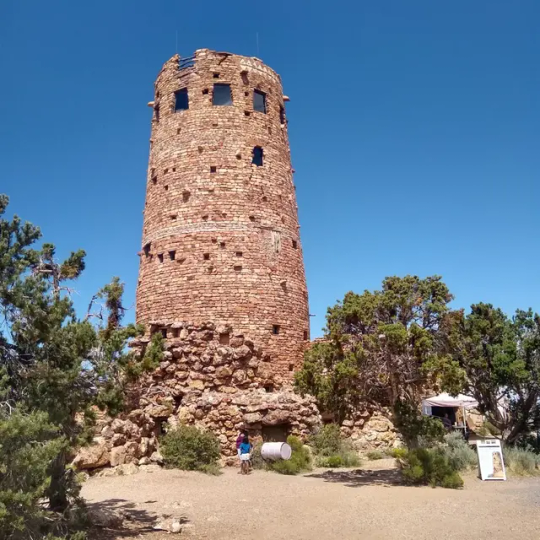
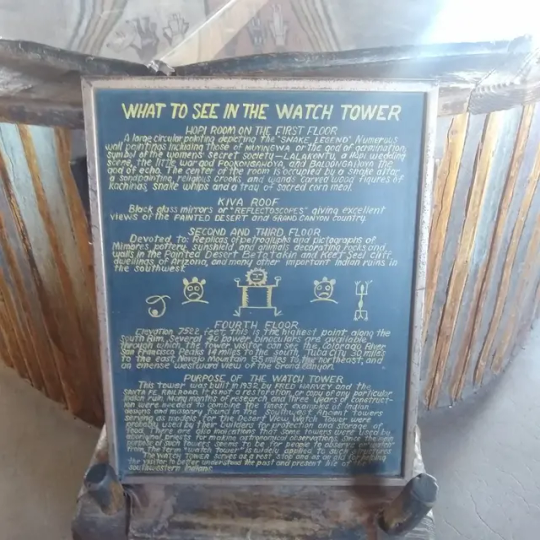
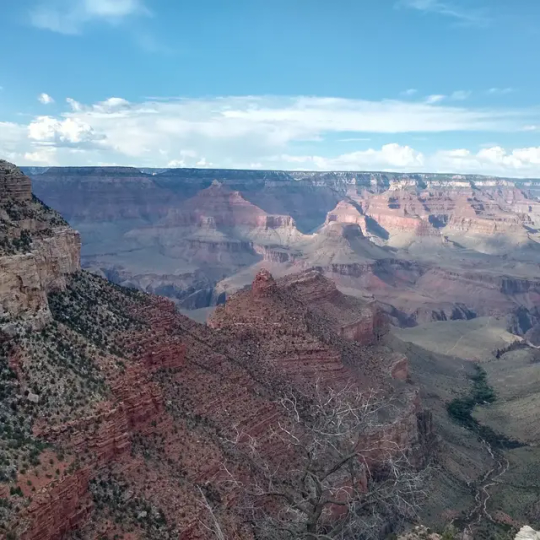
However, because of chance weather conditions, Kermit found his time in the South Rim to be spiritual and enlightening.
He spent most of the day hiking around the south rim. There was a bus that went to all the lookout points, and Kermit was in and out of this bus all day. He saw every point, but then it started to rain and storm as sunset approached. The wind was so strong, Kermit help onto the railing as he stared off into the canyon, watching sheets of rain pour down over the millions of years old stone. Then lightening began to streak the sky, and the canyon lit up like fire.
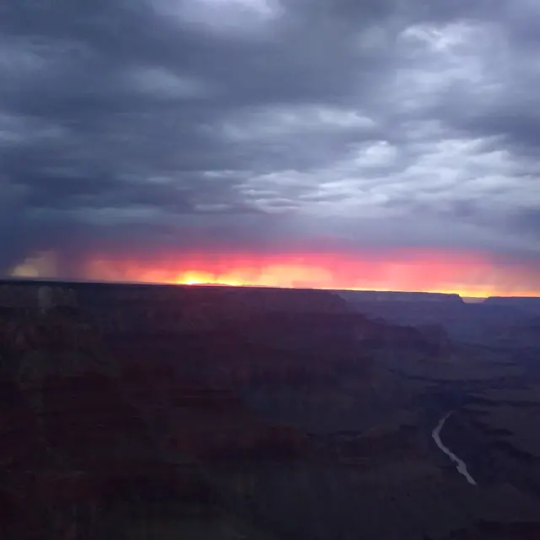
Kermit sat there for two hours as the rain soaked him, watching the same thing that must have been happening for millions of years. He imagined he could see dinosaurs walking the canyon bottom, and when the Condors began to circle the skies, he supposed he was watching dinosaurs even now.
3 notes
·
View notes
Text
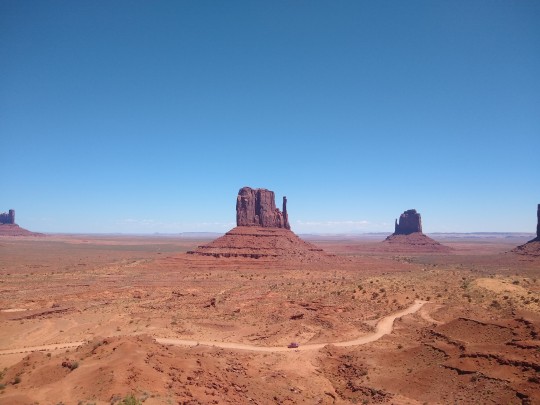
On his way to the Grand Canyon, Kermit made a small detour to Monument Valley! The valley is run by the Navajo, and while there aren't many hiking trails, there was a long scenic drive through the monuments.
Kermit did a short four mile hike around one of the monuments. Because it was going to quickly heat up in the valley, no hiking was allowed after 11 AM. Kermit was the only one out on the trail, and while it was hot, the valley had a nice breeze which kept him cool.
The trail had lots of signs identifying what different plants were. He remembered a few from his time in Canyon De Chelly--ones used as medicine, or used to make rope.
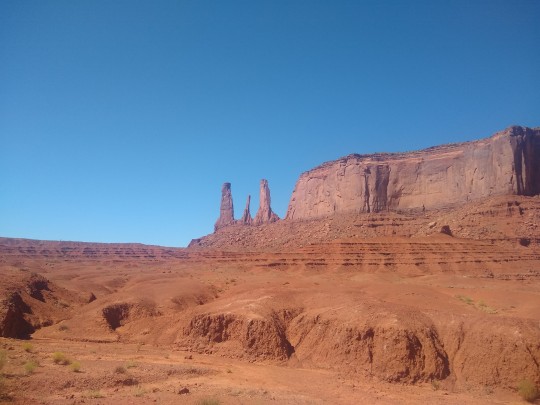
After his hike he drove the scenic loop. The road was very rough but the views were beautiful. He stopped at Code Talker point where an emaciated res dog was pitifully standing near people's cars. Kermit poured a little water into a dish for him but he didn't seem to want it. Then Kermit dug out a few scraps of food, which the dog eagerly gobbled up.

On the drive back, Kermit passed a roadside stand where some Navajo women were selling jewelry (very common in most of the areas Kermit had traveled). Kermit chatted with them a bit--all the vendors were related, each table was jewelry made my a different family member. Mother, daughter, grandmother, etc.
They asked about Kermit's travels. When he told them about what had happened to his car, the woman said someone must be wishing ill on him, and that she could sense Kermit had bad luck or bad vibes! She told him a few things he could do to try to fix his bad luck. Some involved dried herbs, but she also said arrowheads generally bring good luck.
With two separate Navajo hundreds of miles apart telling Kermit in a three day span that he was being cursed/had bad vibes, Kermit found an arrowhead he liked and hung it from his rearview mirror.
The arrowhead necklace was made by the woman's grandmother, from a rock taken from monument valley. The cord was made from deer sinew, which was waxed.
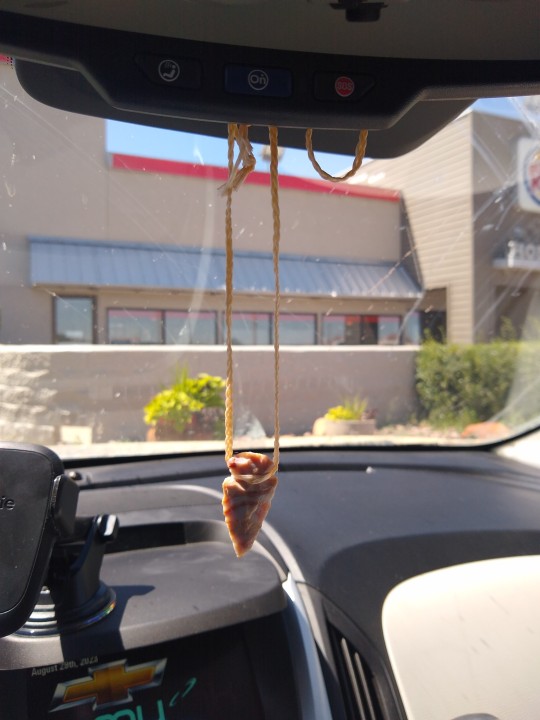
So far, Kermit is happy to report that the arrowhead seems to be working!
6 notes
·
View notes
Text

This update took a while for Kermit to post because he had so much to share! After replacing his tires, Kermit was finally ready for his tour of Canyon De Chelly. Though Kermit booked a public tour, the park wasn't busy, so he was the only tour guest!
Kermit and the tour guide, Leander, clicked right away. He was frank and invited Kermit to ask any questions they had, and not to worry about offending him! Kermit had a LOT of questions, especially considering how long he had talked to other Navajo from the reservation--everything he learned created new questions!
Leander told Kermit about life on the reservation and in the canyon, and some of the social dynamics. For example, one of the families in the canyon dislikes Leander's family for something that happened years and years ago. He also told Kermit that folks on the reservation love TV and movies, and will use movie references quite often in conversation! He recommended 'Reservation Dogs', or the documentary 'The Wonderful World of Whites', if anyone is looking for suggestions.
He also talked a bit about two spirits, and how Navajo were once very accepting of LGBTQ individuals, but how western influences have slowly changed their culture. This has impacted their gender dynamics--men would traditionally marry into the woman's family, as opposed to the woman into the man's family, though this has changed as well.
Leander does a lot to try to improve his community. He's working with a program now that is sort of like big brother, providing positive role models for reservation youths. Leander had to do a lot of the set up himself--in some ways he was handed the materials and told "good luck".
Leander asked about Kermit, and Kermit told him about some of the bad things that had happened on his trip. Leander told Kermit that if he was Navajo, he would say someone was 'witching' him! At the same time, he also said that Kermit's experiences, even if they were hard, let him get a much deeper understanding of the communities he was passing through than he would have otherwise. If he hadn't blown two tires, he never would have met the wonderful family who helped him!
Leander drove Kermit through the canyon and showed him cliff paintings and ruins. Though Leander doesn't have a degree, he's the most knowledgeable person Kermit has met on his travels so far. Leander grew up in the Canyon with his father, who taught him a lot! He knows all of the plants, the cliff paintings, and ruins.

The Ancestral Puebloans used to live in the canyon, but when they left due to drought others like the Hopi (and later, the Navajo) took up their place. Often their dwellings are separate from where they would store their food, either to keep out pests or invaders. Because of the presence of guest houses and exotic goods found in the ruins, it seems that the residents welcomed visitor from far afield.
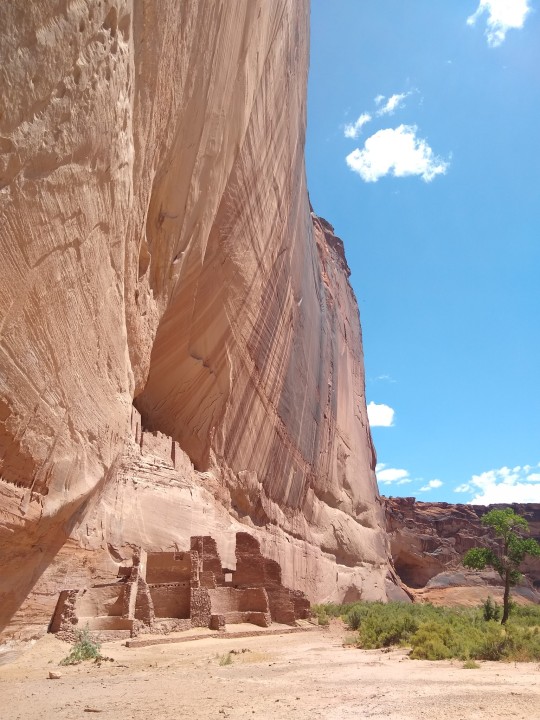
Though the canyon may not look it, it's full of life! There even used to be large fruit orchards. In the 1860's, when the Navajo resisted removal, the US army burned the orchards and killed the livestock. The Navajo were forced to take "the long walk," 300 miles to Fort Sumner New Mexico, where many died. After four years, the relocation experiment failed and the Navajo were allowed to return. When they got there, they found new growth creeping through the ashes of their orchard.
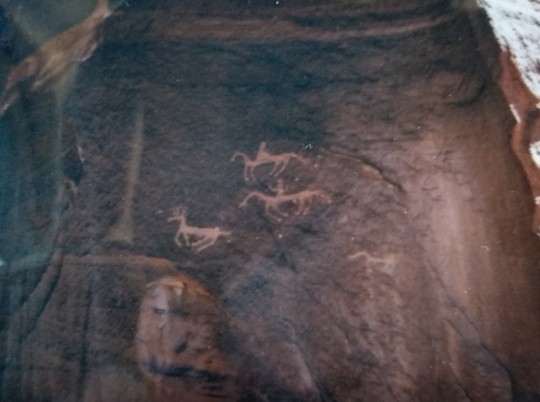
Leander told Kermit a story of a man who hid when the soldiers came. He returned to the canyon to find everyone gone. He waited and no one returned, so he wandered in search of his people. Eventually he found two other Navajo women, also hiding. They waited until their people returned.
He also showed Kermit how to eat cactus fruit. He separated the fruit from the plant with a stick, because the outside of the fruits are covered in spines. Then he rubbed the spines off with another plant, and cut the fruit open. It was delicious. The texture was similar to watermelon. The fruit enveloped seeds which had to be spit out.
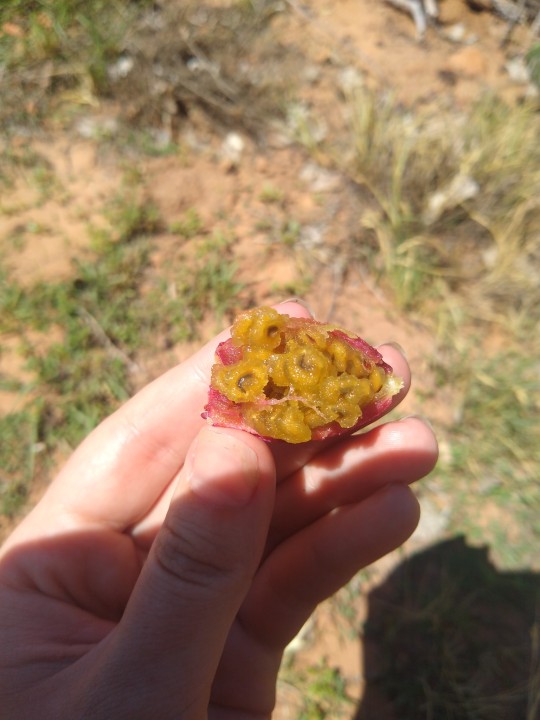
On the cactus fruit was a white substance, beetle dung, called cochineal. When rubbed together, it turns from white to red! Navajo would use this as a dye, or as face paint.
Finally, the tour ended at a small house in the canyon. Leander's aunt lives in the canyon year-round making traditional Navajo blankets. She occasionally takes apprentices, though she never charges them for her time. She has a fruit orchard, and in her backyard, up one of the canyon cliffs, are more ruins. Right there! In her backyard!
Before they parted, Leander suggested that Kermit go and see Spider Rock, which he did. According to Navajo legend, a woman lived at the top of the rock. She descended to teach the native people how to weave baskets, and she also taught the changing woman something important (Kermit can't remember what, and he's very upset about it!). Navajo mothers would use Spider Woman to keep their children in line--if you aren't good, the spider woman will take you to the top of her rock and eat you! That's why the top is white--from children's bones! Kermit thinks that if more people knew about Spider Woman, she would be a lesbian icon.
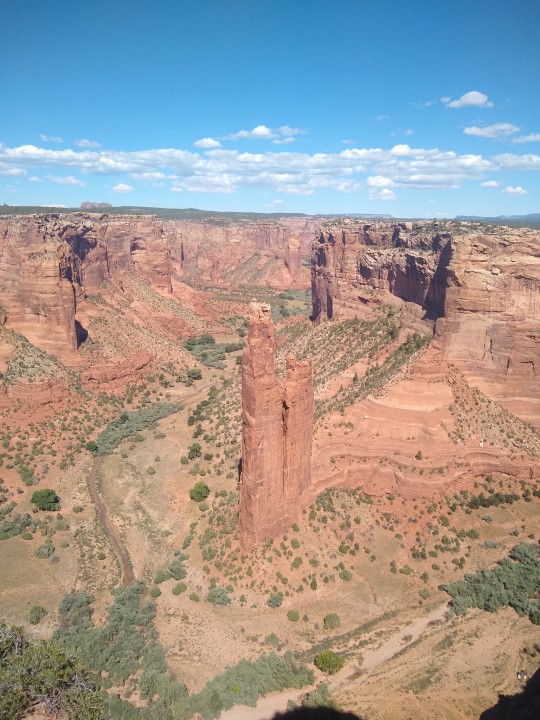
4 notes
·
View notes
Text
Kermit's next stop was Canyon De Chelly (D'Shay). While the canyon is a national monument, you can't enter it unless you have a Navajo guide--Navajo people still live there!
The canyon is deep into the Navajo Reservation, and coming over the mountains near Red Valley, Kermit lost his cell signal and his GPS stopped working. He passed a local hitchhiking, so Kermit stopped and picked him up. He was able to give Kermit directions, and also told Kermit a lot about the area!
Kermit booked a tour with Beauty Way Jeep Tours. He left his campsite at 7AM to drive to the other end of the canyon to meet his tour guide. On the way, a car began to drive erratically behind him. Kermit thought they were probably drunk, so he pulled over to let them pass. As soon as Kermit pulled over, he heard a loud pop. His stomach sank. He pulled over on the side of the road and discovered he had two very flat tires. He was stranded! Again!
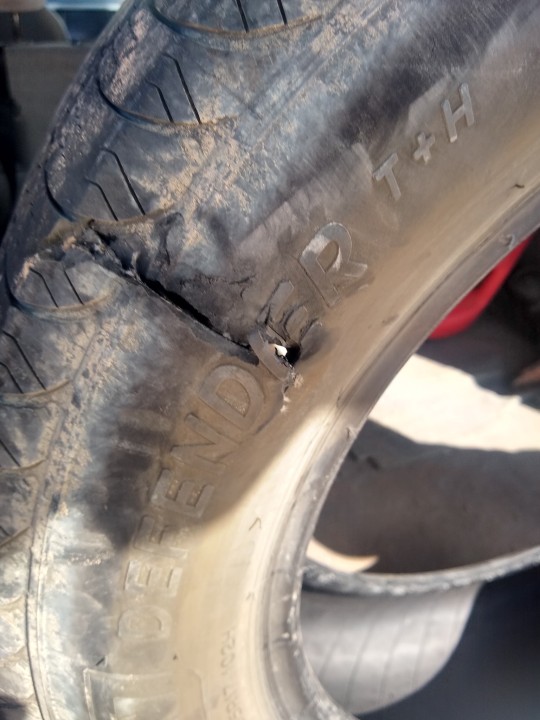

He only had one spare tire. He tried to flag a car down on the side of the road but no one would stop. He had no cell signal (again!). He was going to miss his tour. He despaired. How could this happen twice in three days? Suicide Kermit has been delivered from death, yet was it only to continue suffering in the mortal coil?
Finally, a local man on his way to work with his wife and five year old daughter saw Kermit and stopped. The man was going to be late for work, but he told Kermit it was more important to help someone in need (it helped that the man hated his job and didn't want to go). He said that nobody else on the reservation would have stopped. He also explained that you should never pull onto the shoulder in certain parts of the reservation, because it is quite common for street signs to be vandalized and cut down, leaving jagged metal behind.
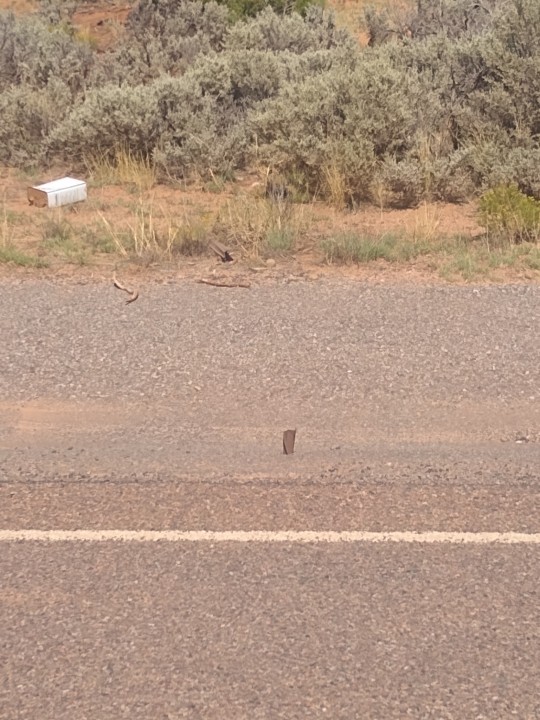
The man put Kermit's spare on, but he still was one tire short of driving. They let Kermit use their phone to call the tour operator, who was AMAZING and fine with Kermit rescheduling. They drove Kermit to town, where a man was selling used tires out of his truck on the side of the road.
Kermit stood back while the man spoke to the tire salesman in a language Kermit didn't recognize. After a few minutes the man returned--there was only one tire of the right size, but the salesman would sell it and put it on the rim for forty dollars.
The man drove Kermit back to his car and put the new tire on, then Kermit followed the man's car back into town to a second tire salesman, where they replaced the spare, also for forty dollars.
By this time everyone was starving. Kermit was profusely thankful. He couldn't believe someone would do all that for him! He offered to buy the man and his family lunch. The man had to go to work, but his wife took Kermit up on his offer.
They went to the Thunderbird Lodge where Kermit ordered a fry bread taco. Kermit spoke to the man's wife for about an hour. She was six months pregnant, and told Kermit about the restrictions Navajo women are under while pregnant. They can't tie anything, and their husbands can't fish, for example. He was surprised to learn that the Navajo on the reservation practice so many traditions. They go to medicine men and practice coming of age ceremonies, as another example.
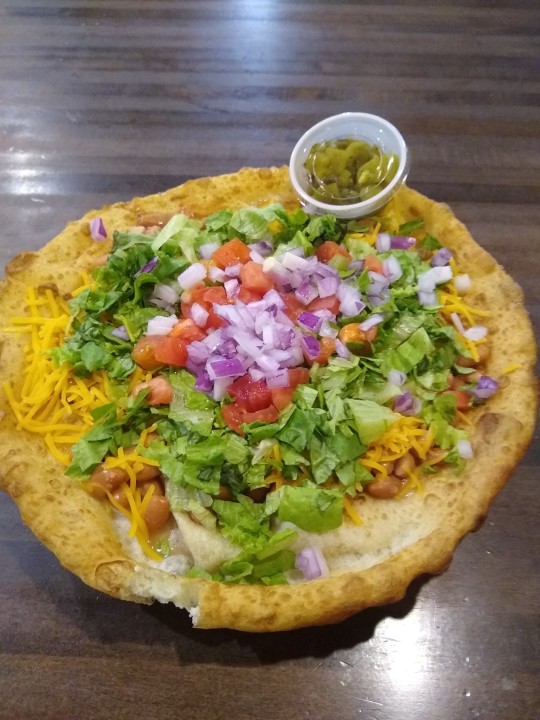
She also talked about some of the struggles she faced growing up on the reservation. Substance abuse had a long history in her family, and she said it was the same for most families on the reservation. She talked about the domestic violence both her and her mother have faced, and how she's doing her best to break the cycle, like a lot of her contemporaries, but it's incredibly difficult given the lack of resources in the Navajo Nation (Kermit's tour guide would talk about some of the things being done to combat this, later!)
Despite this, she spoke with a lot of love for the place where she lived. Everyone on the reservation knows everyone, she said, which can be stifling, because everyone gossips, but the community can be vibrant, and her family is large. If she moved, she wouldn't be able to practice her traditions in the same way.
2 notes
·
View notes
Text
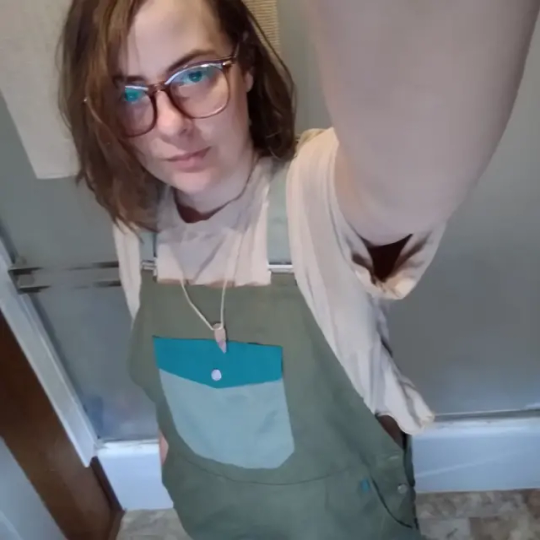

Kermit says just because you live in your car doesn't mean you can't be stylish!
7 notes
·
View notes
Text
At the visitor center, Kermit asked advice on which road to take. He was heading east, but he'd heard the south road was even worse than the one he came in on. The ranger told him to definitely take the south road over the north road. That it was better than some of the roads if he went north, and that while it was muddy, his two wheel drive car should be able to handle it!
Kermit left the park by the south road and got stuck immediately. His car slid through a mud pile and into a water filled ditch. He wiggled to try to get out for forty five minutes, hoping a car would come by. None did. He had no signal.
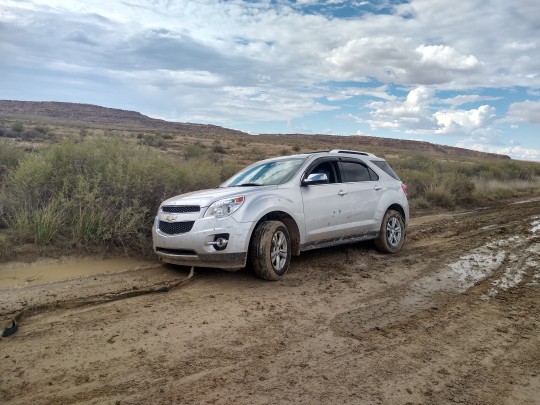
He was four miles from the visitor center, it was blistering hot, he was exhausted. But in the distance he saw rain clouds on the horizon. If he left his car and it rained, his car would flood, probably totalling it. That area is notorious for flash flooding.
Kermit filled up his water bottle, grabbed his hat, and started the long, slow hike back to the visitor center. He was feeling the effects of the heat and his earlier hiking. He stopped frequently to take small sips of water.

He managed almost all of the four mile walk before he finally managed to flag down the first car that passed. The woman was happy to drive the dripping-sweat Kermit the few hundred feet to the visitor center.
Inside, the park rangers told Kermit he would have to call a tow truck. Because the canyon was so remote, not many tow companies would go out there. Kermit called the number they gave him. He was told it would be $500 minimum, plus a two hour wait.
Kermit had no other options. He just had to hope his insurance would reimburse him..He sat in the visitor center cooling down, sipping water. One of the park rangers (the one that gave the bad advice fled when he heard Kermit had gotten stuck) chatted with Kermit while he waited.
Finally, the tow truck arrived. The driver was very nice and picked Kermit up at the visitor center. He offered Kermit cold Gatorade, and when he'd finally unstuck the car, he gave Kermit tips on driving through mud and followed him the whole way back to the park to make sure he didn't get stuck again. He even refused Kermit's tip because he knew how expensive the towing was!
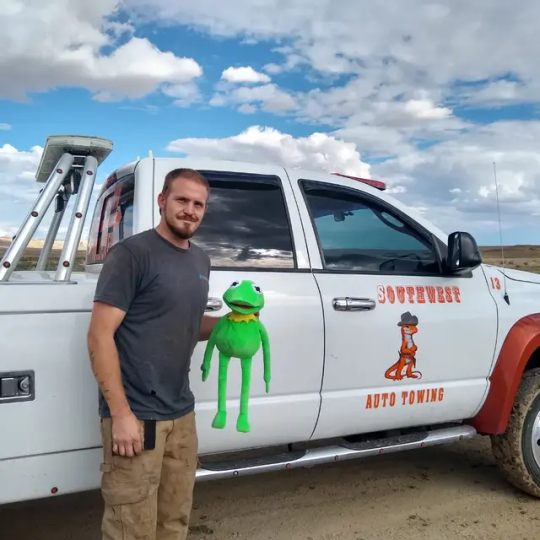
Kermit still didn't have Internet when he left the park, but he forwarded the tow bill ($700!!) to his insurance agent in an email using the WiFi of the first McDonald's he came to. It took a few days for the agent to get back to Kermit, but he was informed that insurance would NOT be covering the bill.
Kermit ran his head over with his car. Because his head is all stuffing, he was not harmed.
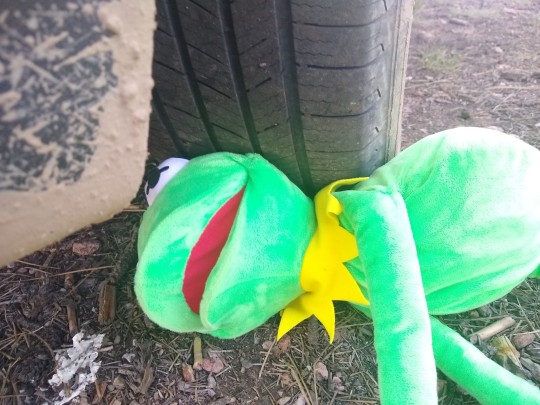
Kermit has now added a donation link to his profile, where you can buy Kermit hot food or help pay his massive tow bill!
3 notes
·
View notes
Text
Chaco Canyon was incredibly remote. Kermit drove in on ten miles of very rough and rocky dirt roads. He was mad at his GPS taking him the back way, only to later discover the other road into the canyon was even worse!
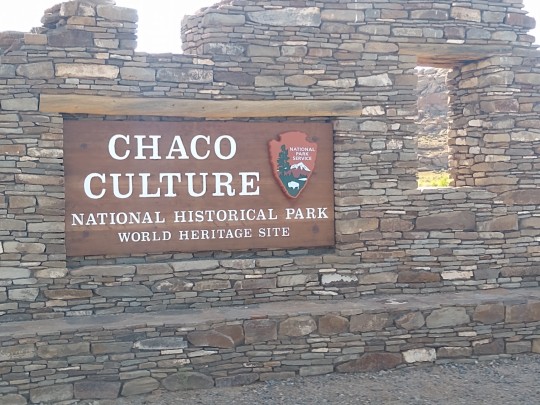
He stayed the night in the campground. In the morning he did the loop drive to see all the ancient long houses, which had been reconstructed by an archeological team in the 1890s.
At the visitor center he learned that the Chacoans lived all over the state! From 900-1200 AD they seemed to be a trading hub--archaeologists uncovered fragments of cocoa beans from South America, exotic dyes, and even macaw bones! People must have traveled thousands of miles to this canyon in New Mexico to trade with the Choacans.
At the Park Ranger's advice, he did the six mile Pueblo Alto Loop hike, which took him rock scrambling up the cliff walls to the top of the bluffs, where he could see the ruins better than anyone on the ground.


The hike was incredibly strenuous because of how much the trail dipped and climbed. The trail was marked mostly only by rock cairns, so it was easy to lose the path. At one point, the path required Kermit to scale the miniscule space between two boulders, wide enough only for one foot at a time.
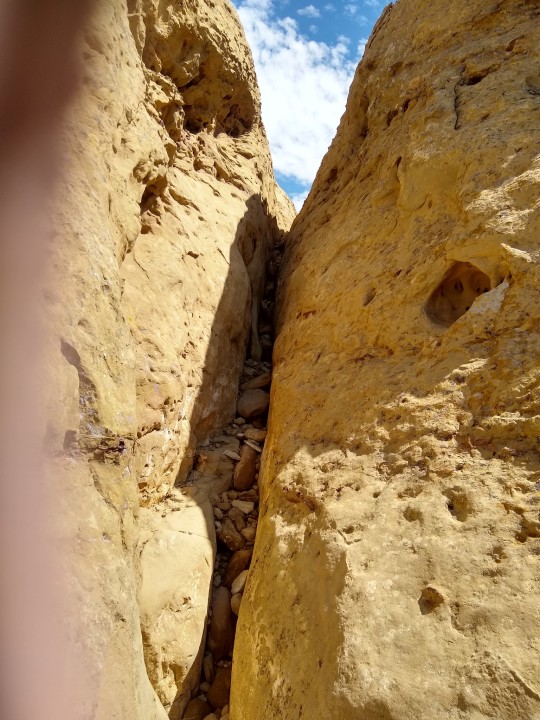
Eventually he came to one of the coolest sights in the park: ancient Chacoan stairs carved into the cliff face! Apparently the Chacoans preferred to go over obstacles as opposed to around. Imagine them climbing up and down these stairs with baskets of trade goods strapped to their backs!
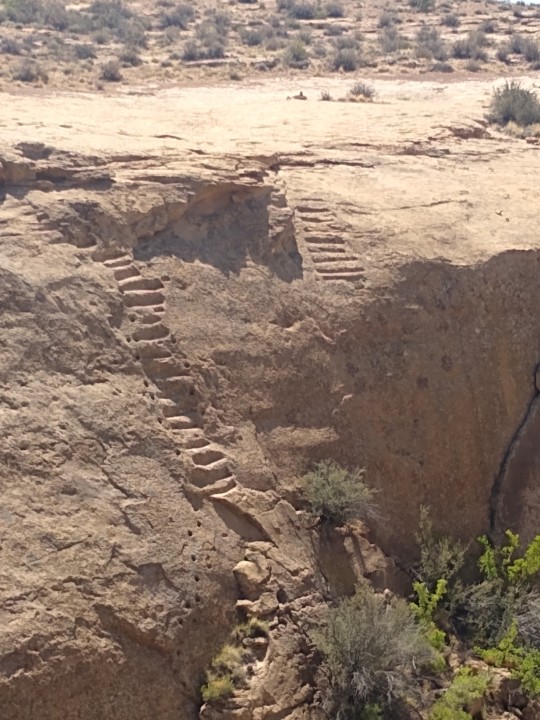
After the stairs, Kermit came to another ruin, which hikers were allowed to walk around in. The doors were very small, only a few feet high. According to Kermit's guide at Canyon De Chelly (more on that later), ancestral Puebloans were only a little more than five feet tall!
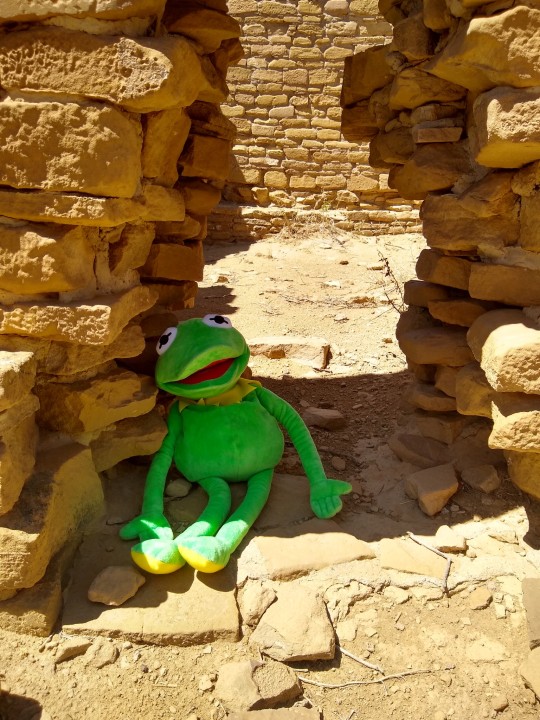
Kermit also passed a number of strange formations in the rock. Millions of years ago the entire valley was covered by water. These are old, fossilized shrimp burrows!
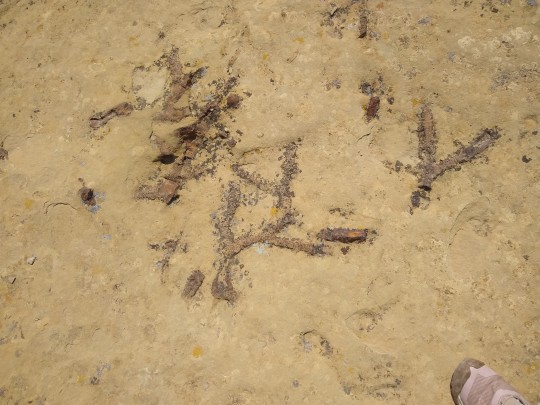
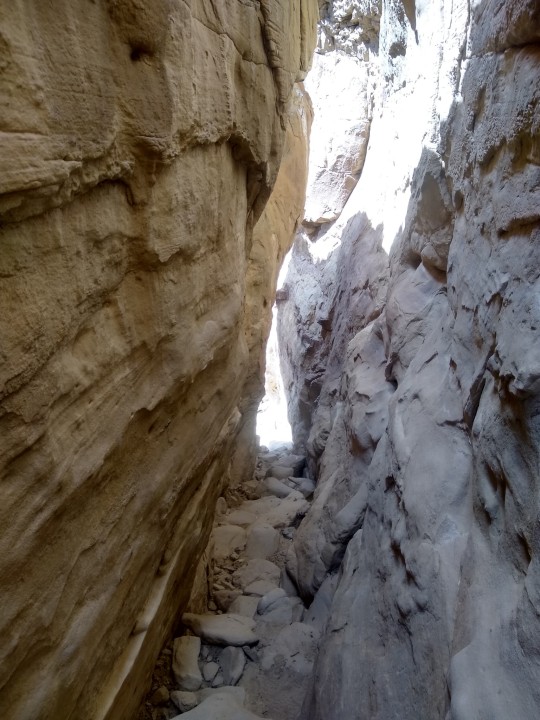
Finally, Kermit hiked back down, scrambling over boulders and between two massive rocks. It was time to leave the park, and he was so exhausted from hiking in the heat the he wanted to do nothing more than lay down in his car. His legs felt like jelly!
4 notes
·
View notes
Text
After Los Alamos, Kermit headed to Bandelier National park. Because the infrastructure of the park is so old, Kermit had to take a bus to the visitor center.

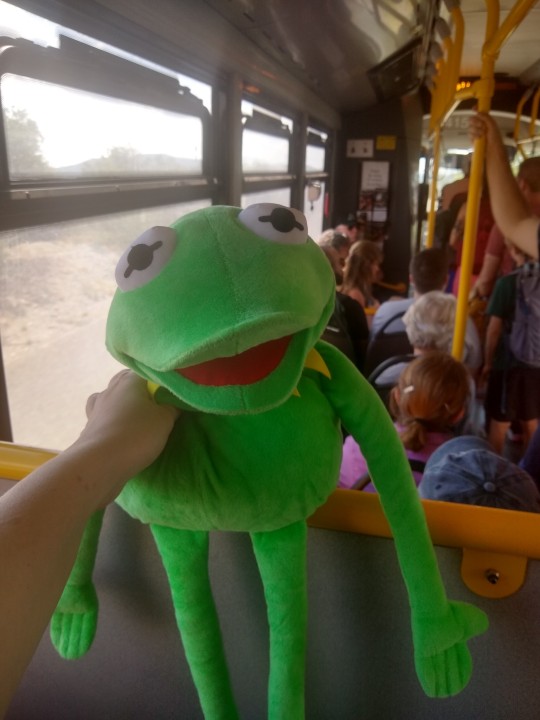
At the visitor center, a park ranger greeted them and explained some safety regulations. Because it was so hot he encouraged everyone to take a lot of water even though the hiking path to the cliff dwellings was only a few miles.
He also explained a little history about the park. Ancestral Puebloans had lived in cliff dwellings in the canyon walls around 1150 AD. The cliffs were very defensible as they were accessible only by scaling the canyon walls or by large ladders.
While the first part of the path was relatively easy, the climb up to the dwellings was more difficult. It was more than worth it, as visitors were allowed to actually climb into the cliff dwellings and walk around inside.
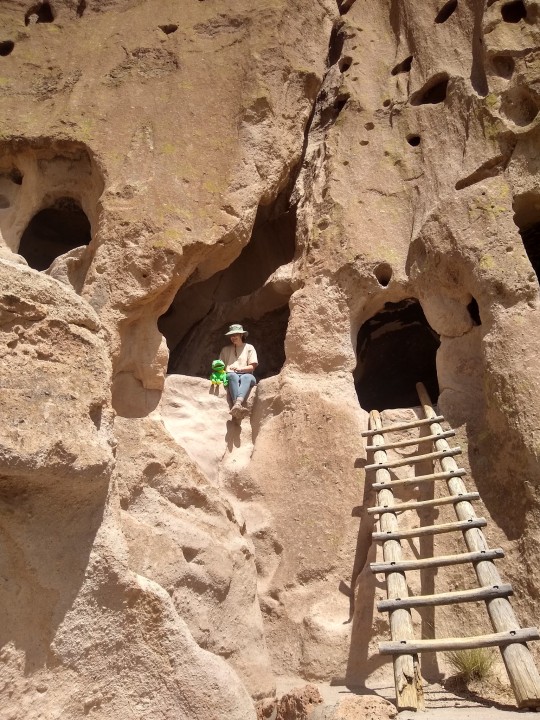
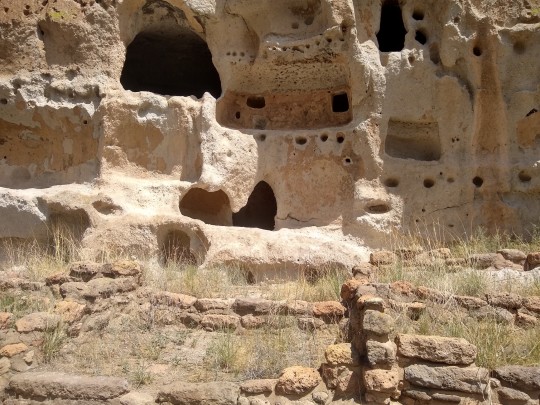
While most of the remaining dwellings were low to the ground, Kermit could see marks in the stones higher up where more dwellings existed hundreds of years ago.
The final dwelling was a *very* long climb up a series of ladders. Because the path was so thin, Kermit had to cling to the rock wall while others passed in the opposite direction.
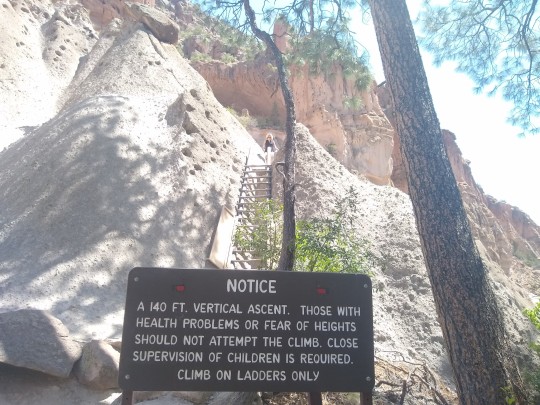
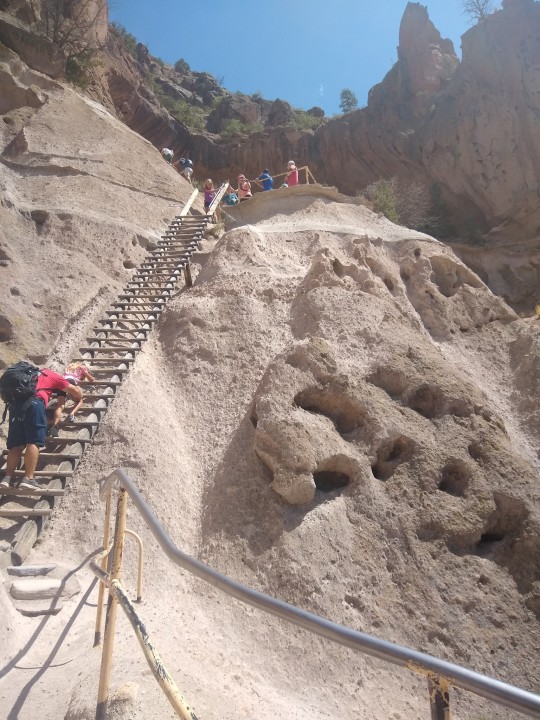
At the top of the ladder was this dwelling, which was different from the other cliff dwellings we saw!
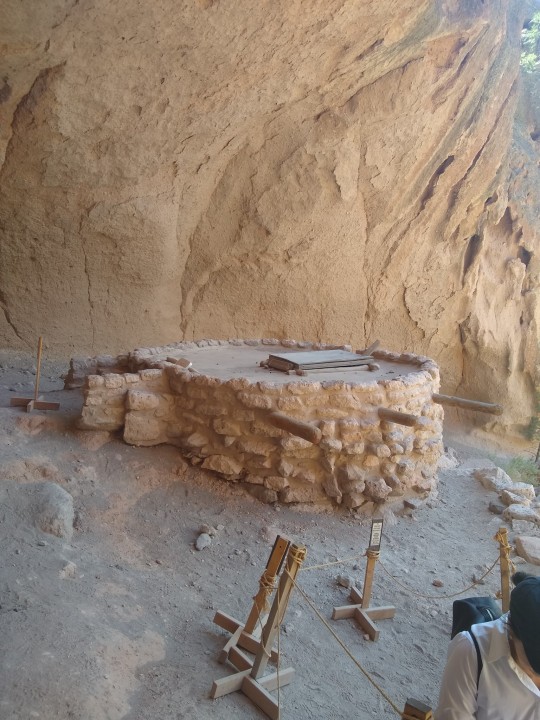
This was a building known as a Kiva, used for ceremonies and also sometimes for living. Kermit would be travelling to two other sites where these puebloans live. Did these puebloans trade with the puebloans at Chaco canyon and Canyon de Chelly, where Kermit would be heading?
After hiking back to the visitor center, Kermit enjoyed some ice cream to cool off before heading to Chaco Canyon! (The drive was beautiful.)
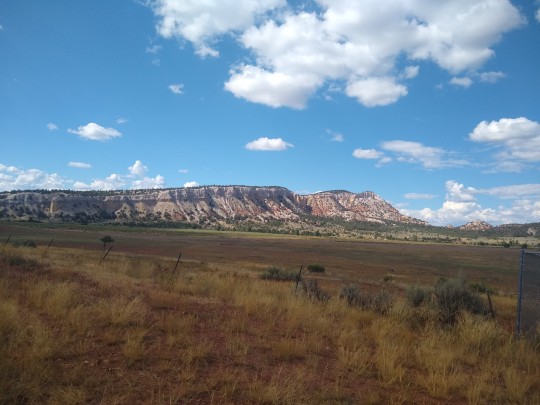
3 notes
·
View notes
Text

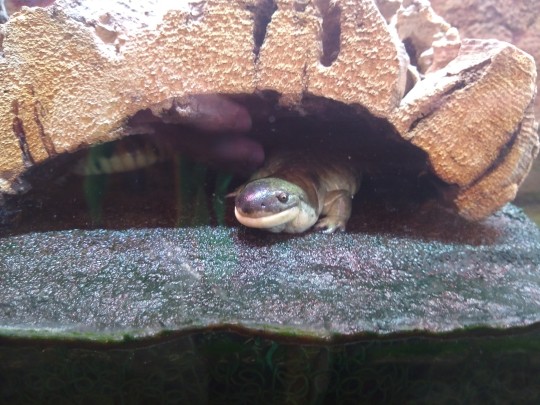
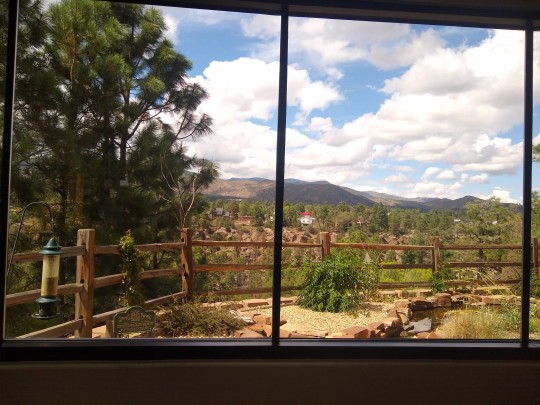
The last thing Kermit did was visit the local Los Alamos nature center. This seemed more for kids, but since Kermit is a child at heart, he loved it.
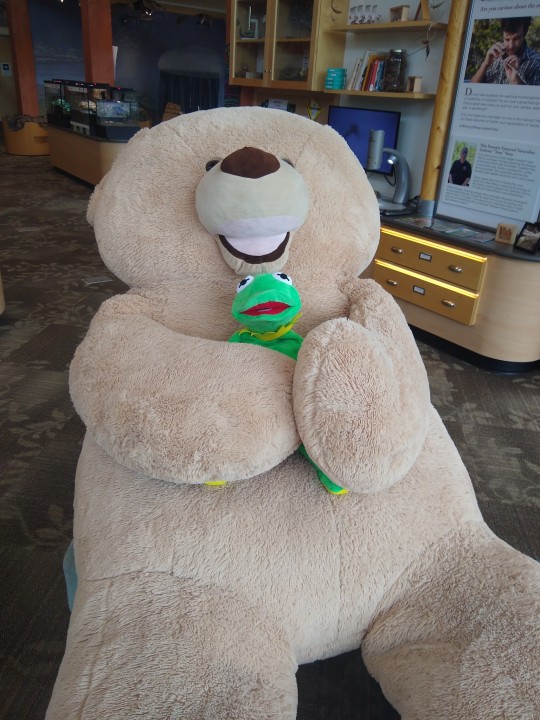
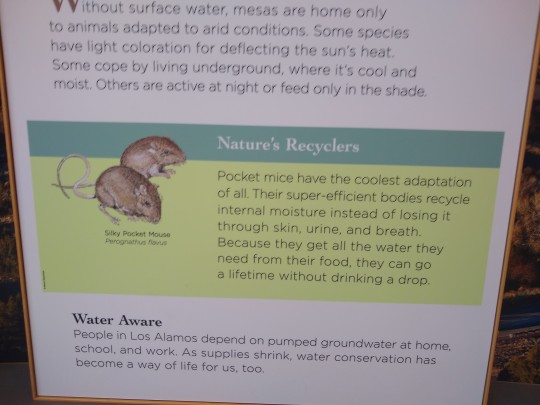
Kermit wishes he didn't need to drink gallons of water every day.
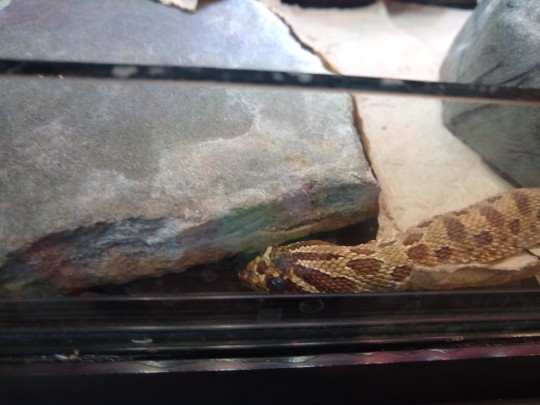
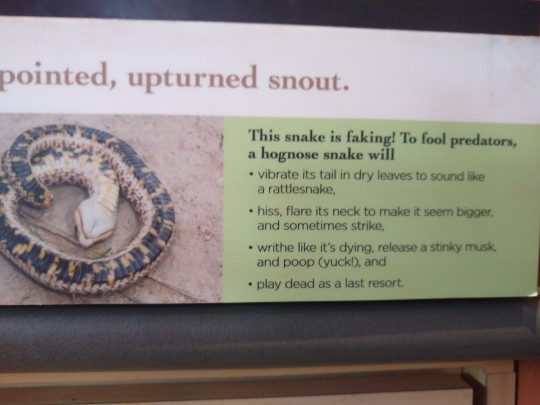
(relatable)
After checking out the nature center, Kermit went on a short hike through the canyon. Though the hike was only a mile or so, he was very sweaty after, so he went to the YMCA for a shower before driving up into the national forest to camp and do laundry. Just before packing it in for the night he saw this (GIANT) bird. An omen of things to come?
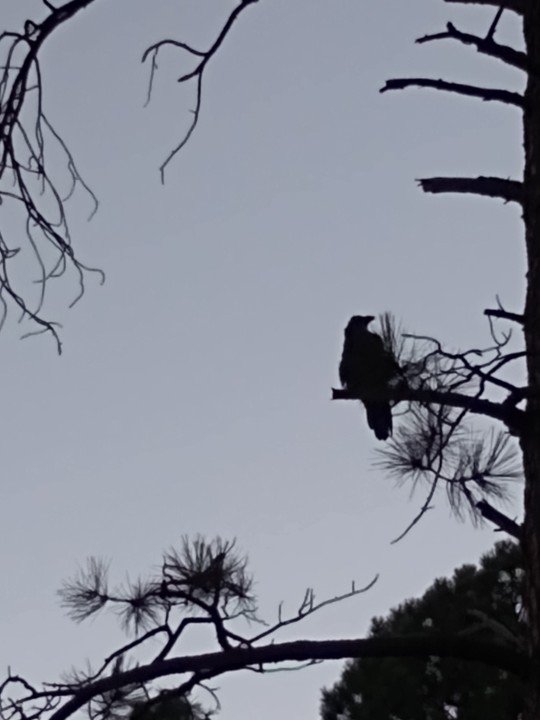
2 notes
·
View notes
Text
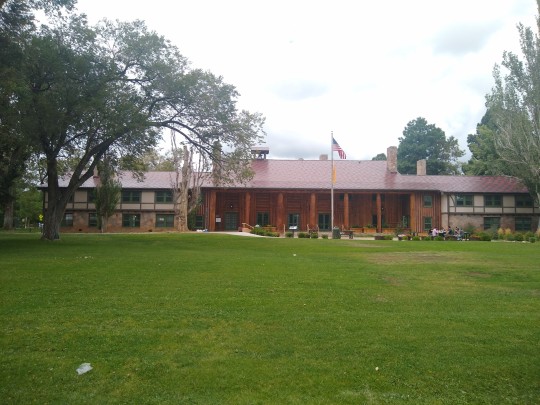
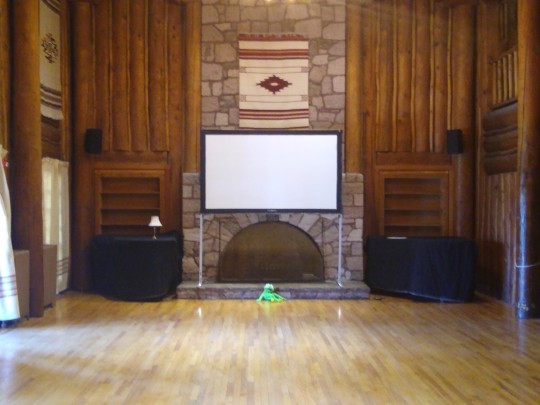
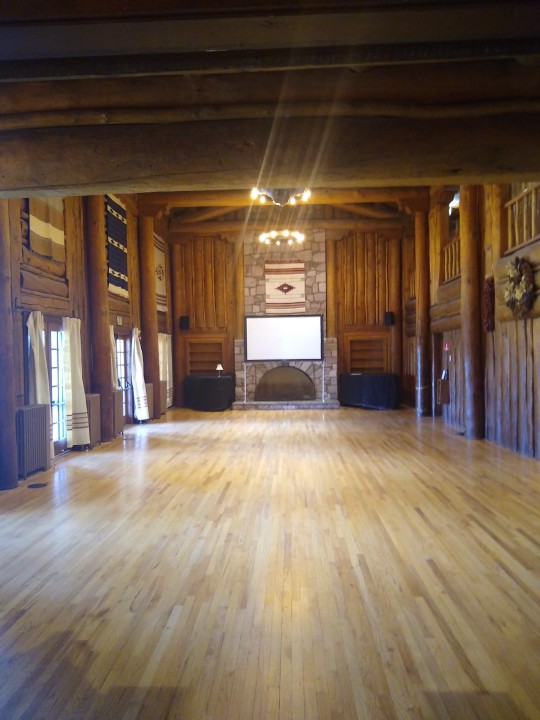
Further down the park was the ranch school building that Oppenheimer lived in for three years while working on the bomb.
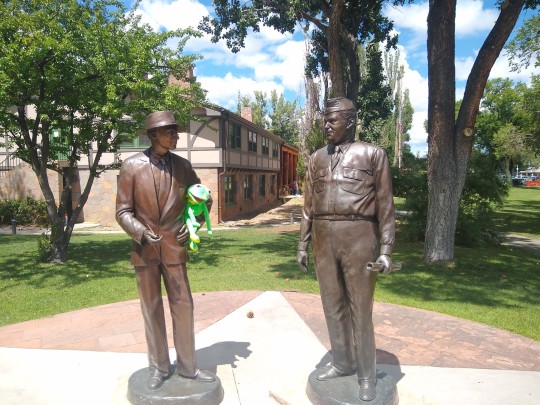
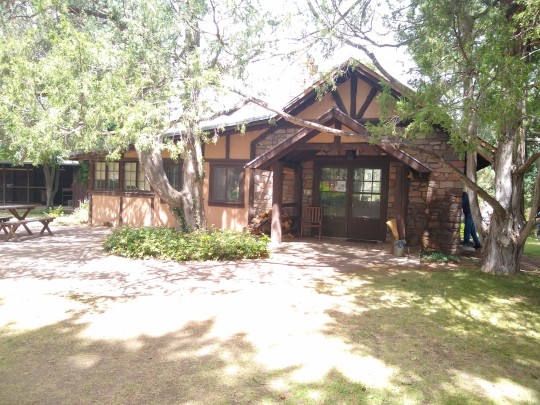
The building was closed to the public for renovations, but you could still see in through the window!
After his time at the museum, Kermit toured the park in town, which still had some of the buildings used during the Manhattan Project. While most of the government buildings had been torn down, buildings from a ranch school for youths, which had been commandeered by the US government for the project, remained.
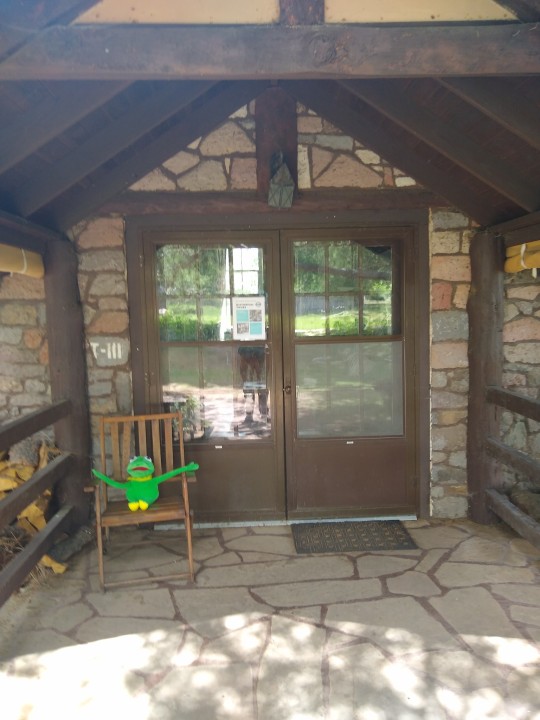
(now Kermit am become death, destroyer of worlds)
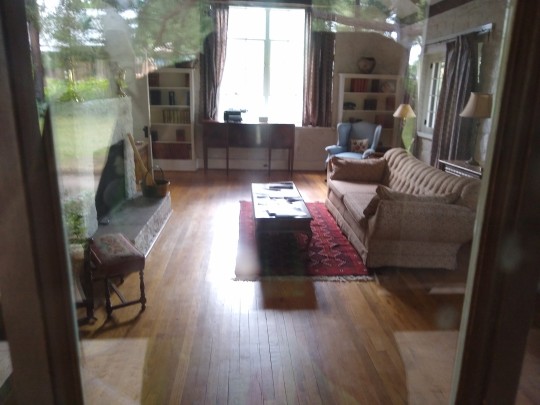
The Fuller Lodge was used for assemblies by the scientists, and also for housing guests. Scenes from the Oppenheimer film were shot here!
Next door was another ranch school house that had been made into a museum. This building had ginkgo saplings gifted by Green Legacy Hiroshima and The Hiroshima Botanical Gardens.

Another building in the park had note cards identifying former students. Apparently Gore Vidal went for a year and hated it!
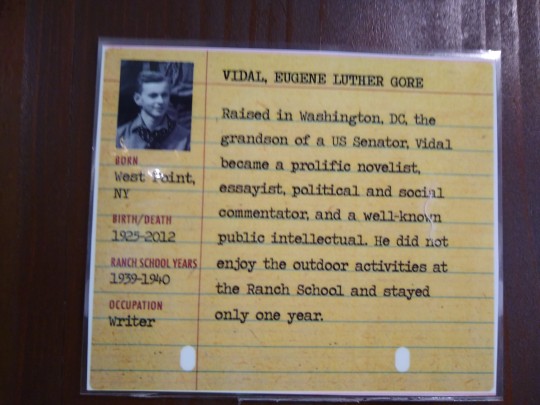
Finally Kermit walked around the lake, which had fish, turtles, ducks, and geese! A lot of life for a city which built the bomb.
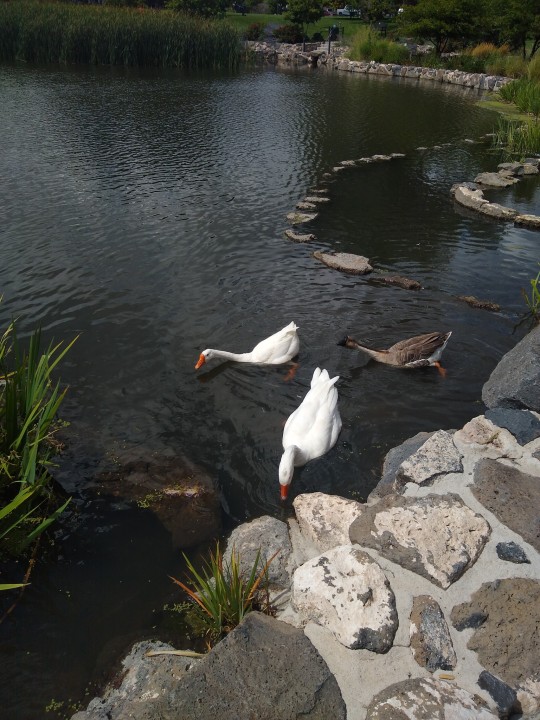
3 notes
·
View notes
Text
Los Alamos, where the US built the nuclear bomb, was only a short drive from Taos. Kermit arrived at the Bradbury Science museum ten minutes before it opened. The museum had an impressive mix of replicas and artifacts from project Manhattan and the atomic age.
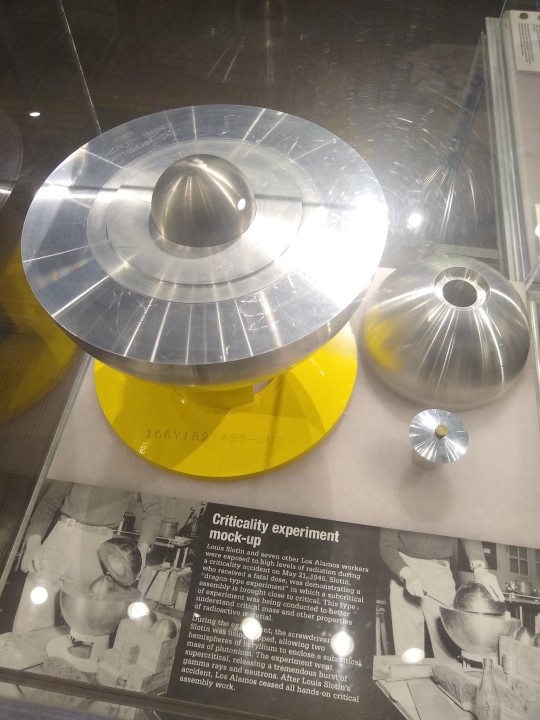
They had a replica of the Demon Core, which went supercritical at a Los Alamos lab when a Scientist slipped and brought the two halves of the sphere into direct contact, issuing an instantaneous fatal dose of radiation to the closest scientists. Some of those further away would develop complications from their exposure and die in the following years.
There was also a scaled down replica of the atom bomb assembly which was dropped at the Trinity test site by Oppenheimer's team!
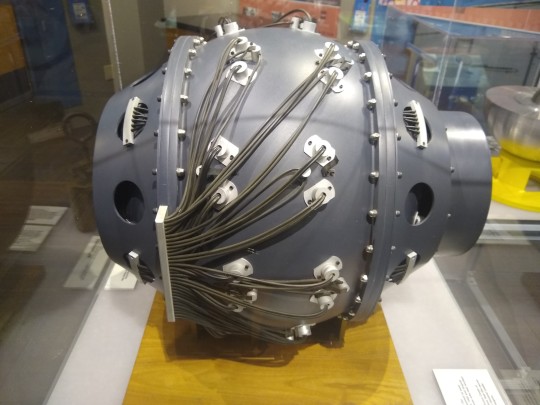
In the same room they had statues of Oppenheimer and General Graves (neither looked to be having a good time. That's what happens when you go from manufacturing atomic annihilation to shaking hands with museum patrons).
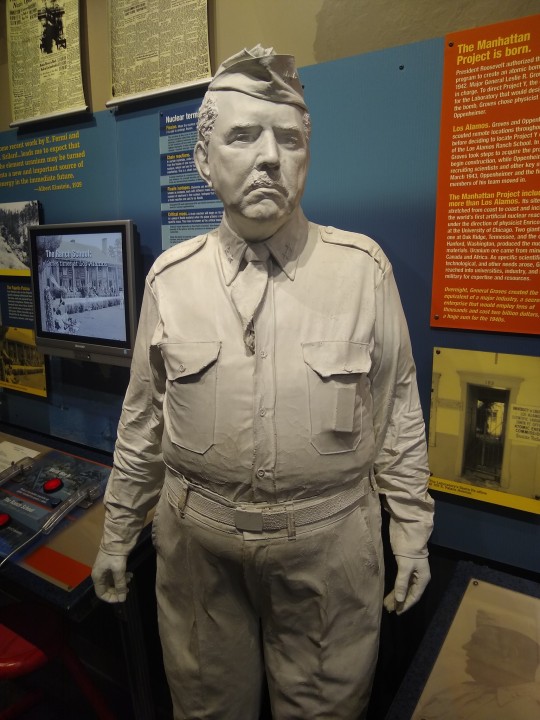
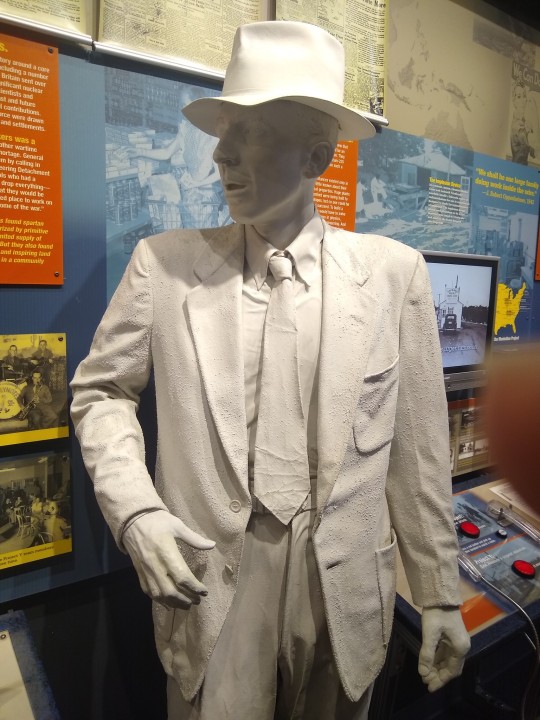
The next room had Oppenheimer's chair, along with a letter signed by Oppenheimer's colleagues and prominent scientists condemning the US government for calling Oppenheimer's security clearance into question. And Oppenheimer's copy of The Bhagavad Gita.
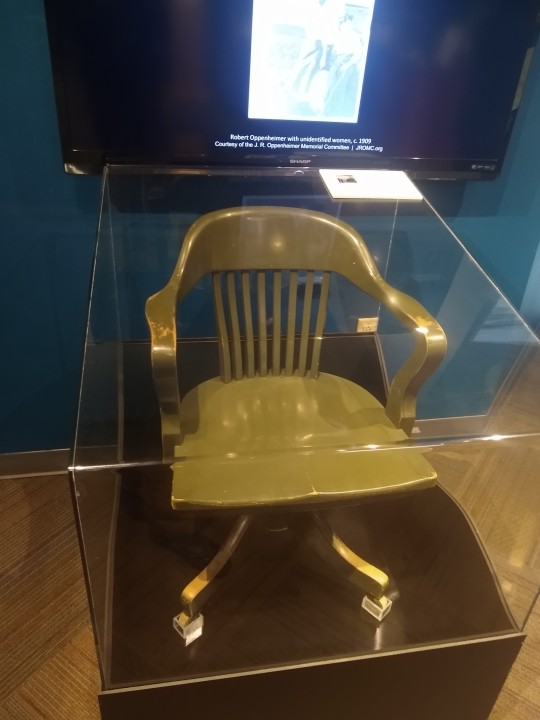
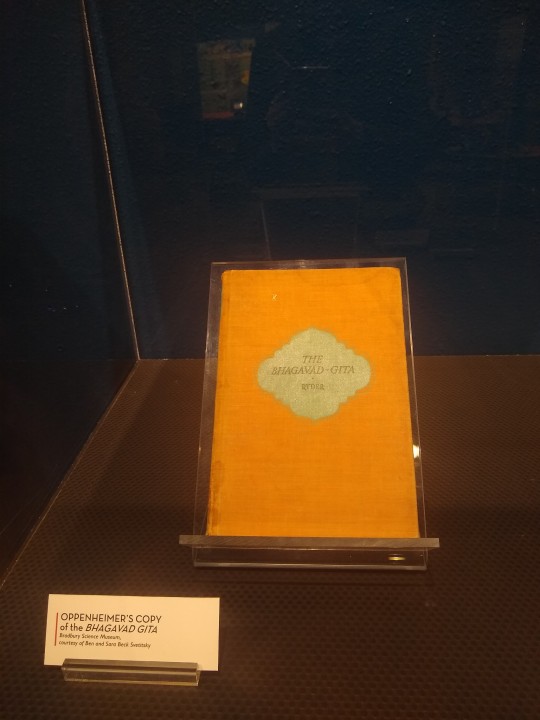
The rest of the museum had exhibits about the things Los Alamos labs work on today, like disease, natural disasters, and climate change. Kermit thought the coolest thing was this chair that simulates different earthquakes!
3 notes
·
View notes
Text

Kermit had no cell service for two days. Kermit got stuck in the mud in the middle of nowhere and had to hike four miles through the desert to get help.
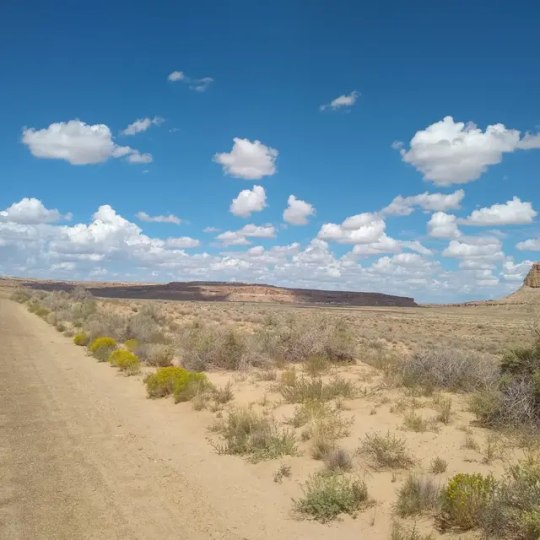
Kermit nearly passed out from heat exhaustion. Kermit is going to bed and will update everyone soon.

4 notes
·
View notes
Text

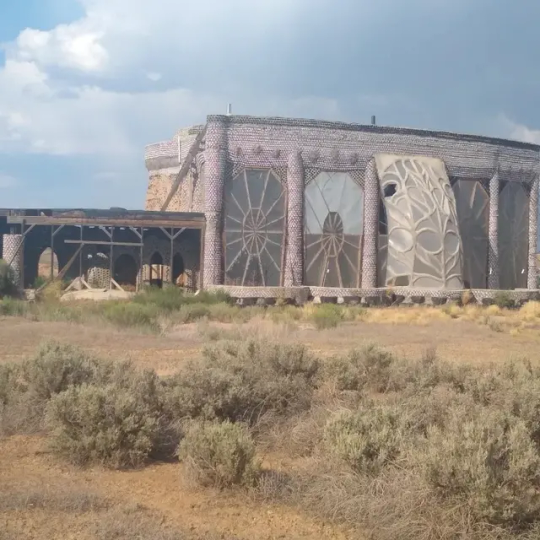
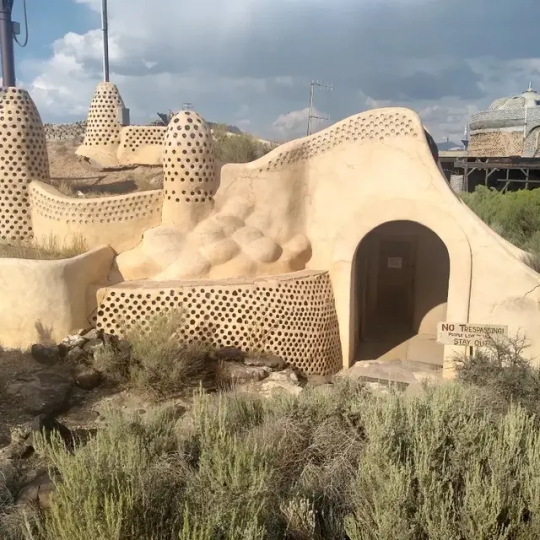

On the way out of Taos, Kermit made one last stop to see the 'earthships' of Taos! These are buildings meant to be environmentally friendly and completely self-sustaining. They're built out of recycled materials like bottles and tires, and they are powered by solar and get their water from rain fall!
5 notes
·
View notes
Text
Kermit spent some time exploring the more commercial parts of town. He went to the Kit Carson museum and talked to the clerk for an hour. The clerk swore up and down that what the Pueblo tour guide said about Kit Carson wasn't true. He said Carson was in California at the time of the burning of the church, and also that the church had only a few women and children but mostly houses revolutionaries. He had an amazing memory for dates, though he couldn't say what the source of the disagreement was, and if historian's had spoken on this. He seemed mostly to be a reader of popular biographies.
Here's a bush the bee's were really digging in the courtyard of Carson's home:
Kermit also visited the art galleries, where a woman showed Kermit the wood blocks she used to make her prints, and talked about how the town had changed since she moved there in the 60's. Further down the street, he met a man who talked to Kermit for over two hours about spherical consciousness, showing Kermit (personally!) Over a dozen of his paintings layered over a custom lighting rig which changed colores to draw out different colors and textures from the canvases. He said his paintings were like stargates, something that once you really saw you would take with you, a way to gaze at the connectedness of things.

On Kermit's last day in town, he hiked a three mile stretch of the Rio Grande, which took him directly along the water and then up to the top of the canyon. Along the way he saw lizards scrambling for shelter in rocky craigs and vultures gliding on warm updrafts rising out of the canyon.
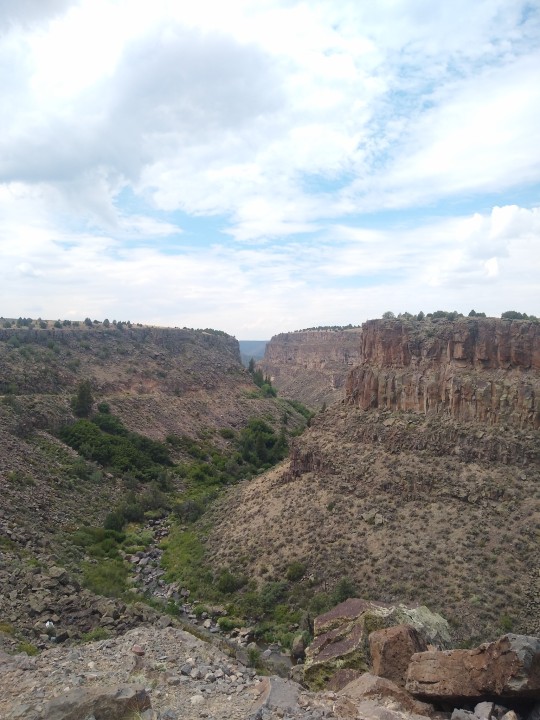
Finally, after three days in Taos, Kermit prepared to head out to the first location the other van lifer's plotted for her (but that she intended to go to anyways!) Los Alamos!
6 notes
·
View notes
Text
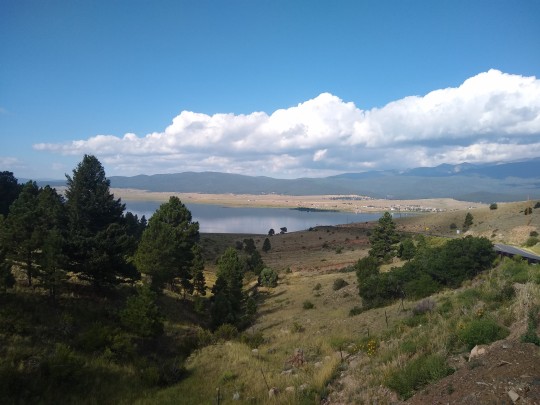
Kermit arrived in Taos early Monday morning and left early Thursday morning. His first stop was Black Rock Hot Springs, a natural hot spring running out of the mountain and into the Rio Grande.
It was a quarter mile hike, made very difficulty by large boulders and loose rocks. The hot springs were very small, two pools filled with slippery, jagged, algae covered rocks.

The first pool was as warm as a hot tub, and the second was pleasantly warm. The river by contrast was nearly freezing despite and heat.
The pools were a bit shallow due to the rocks, so Kermit's handler tried to swim in the freezing river. The river was also rocky, and she slipped a number of times, falling straight into the freezing river and banging herself up.
She swam for an hour while fishermen patrolled the opposite shore. Eventually she moved back to the spring. She met a family who lived in the area. A little later a man in his seventies hiked down (a retired engineer who'd been living in his RV for seven years). Both gave Kermit a list of must see places, and the man effectively mapped Kermit's post-taos route for him on the fly!
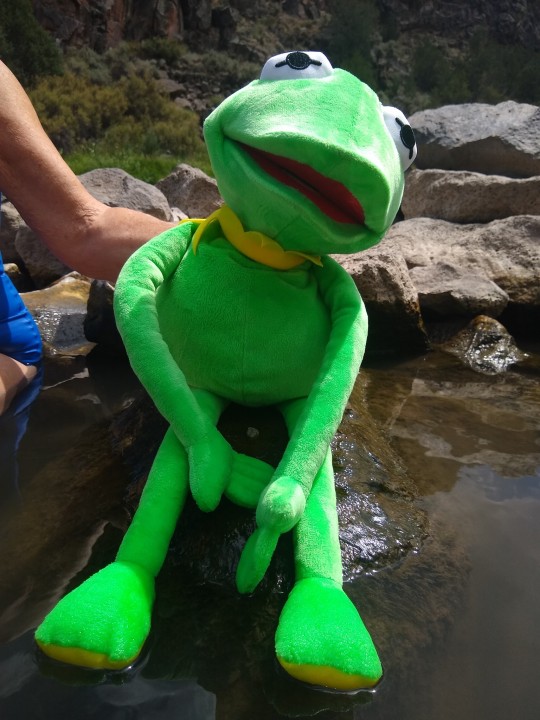
The other hikers and van-lifers were some of the nicest people Kermit met. As he explored the town and Pueblo, the local artists and native americans seemed genuinely joyed to ask Kermit and the other tourists about their travels, where he was headed, and where they came from.
At the Pueblo, a Tiwa man with one arm who sold dream catchers made from the sinew of deer he himself killed told Kermit about life in the Pueblo. His shop was one room in a large, communal adobe house which was once his grandmother's. You can see the sign for his shop below!
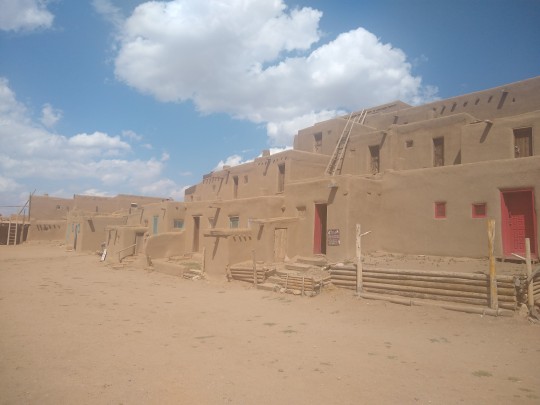
At the Pueblo Kermit also took a tour. The tiwa tour guide discussed the history of the pueblo: how it had once been a thriving community, surrounded by a ten foot wall to repel invaders, but how it had suffered due to Spanish colonization and later, the U.S. army. She said that following the murder of the governor by revolting natives, a U.S. general dispatched Kit Carson to deal with the uprising. The Tiwa women and children hid in the church, which was then burned by the army. The church pictured is one that was built after the other burned.
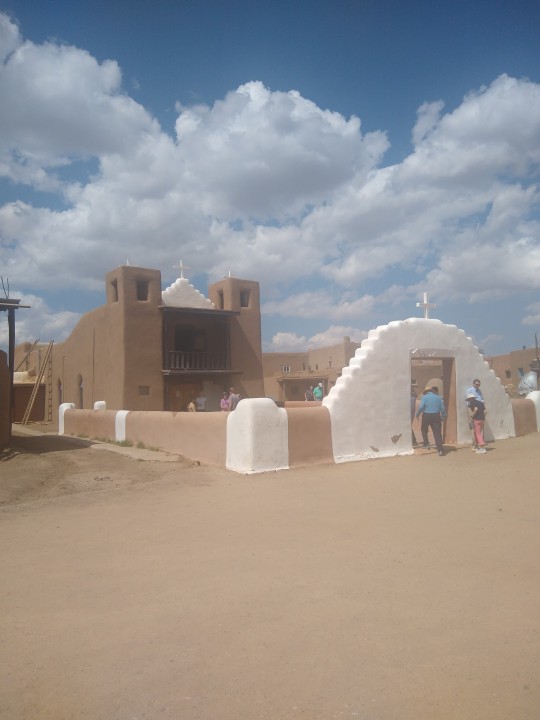
The tour guide explained how some Tiwa still live in the Pueblo today, though many only came back for festivals. It is the responsibility of the families who the adobe homes have passed to to maintain them, as they must be remudded every two to three years, which involved scrapping the outer layer of mud and mixing it back into a paste to spread over the bricks. Kermit got to see this process while he was there!
After the Pueblo Kermit stopped at the Jon Dunn Bridge, which stretched over the Rio Grande.
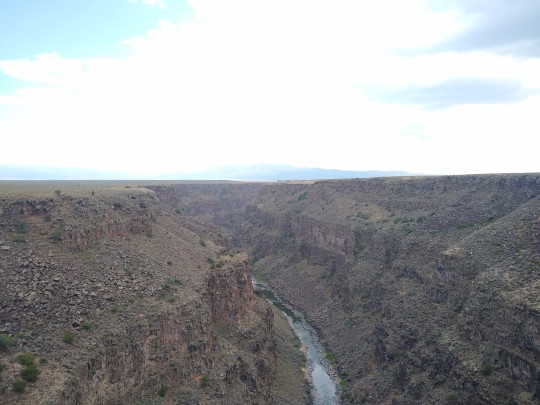
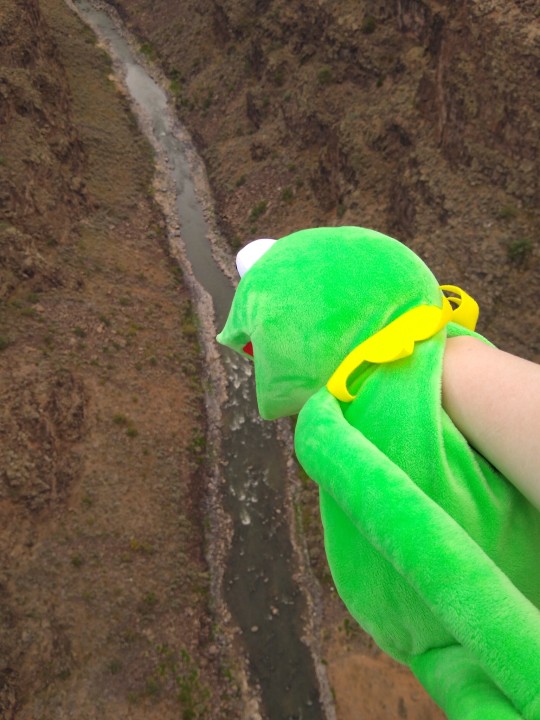
After the bridge, Kermit went to the Taos Skit valley, where he splurged on a ski lift ticket. He rode the lift at least three times! It afforded the most wonderful view of the pine-covered mountains. The workers there were extremely friendly, and we're very excited to tell Kermit about living and working at the ski valley, and told Kermit about the most beautiful parts of the mountain.
Stay tuned for Taos part two!
4 notes
·
View notes
Note
hiiii Mx. Suicide Kermit! I was wondering if you still have a "permanent residence" somewhere, or how you handle things that require an address otherwise. you know like The Bank and shit! that's something that's always concerned me about van life (<- has considered Doing That but most likely Will Not)
Hi! Right now I am using a relatives address as my permanent so that I can get Medicaid and food stamps. The Medicaid doesn't help me much though because it only covers out of state emergency care. Each state has their own residency requirements as well, so the state I'm using will end my benefits after a month or two if I don't return to the state. At that point I can establish residency in Washington State as they have very lax requirements as to allow the homeless access to government assistance.
When I change my residence to Washington I believe I'll have to change my car insurance policy, but im hoping registration is fine to leave until its up for renewal.
Van life is really fun but I suggest doing a trial run for a week or two before deciding to do it for real!
5 notes
·
View notes
